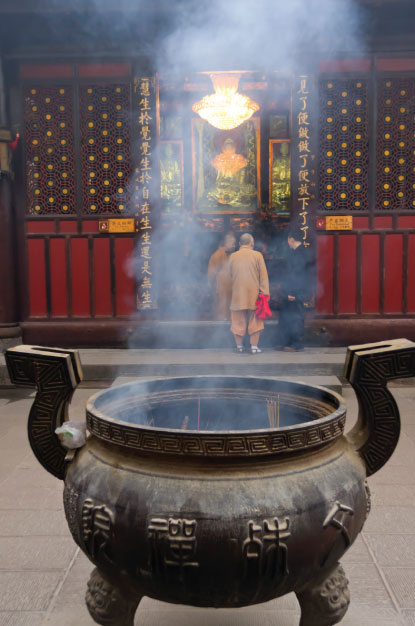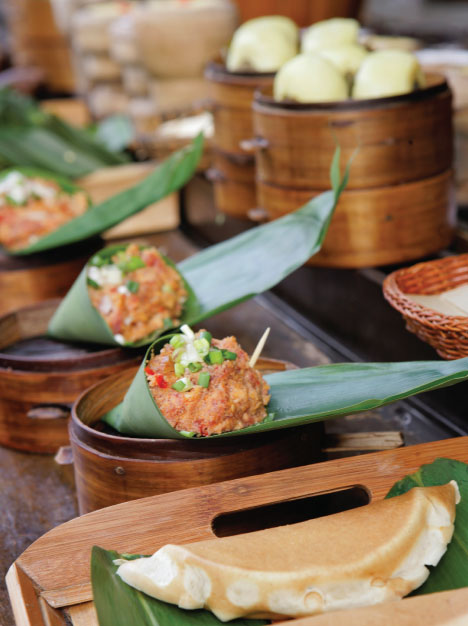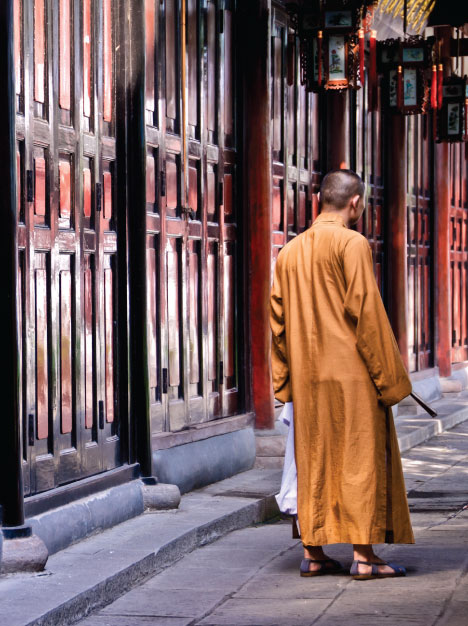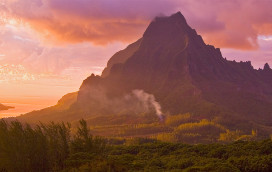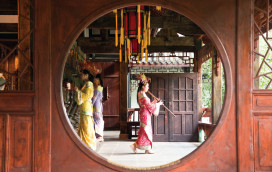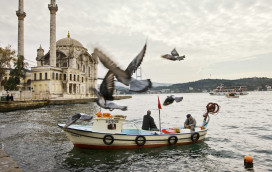When Marco Polo visited Chengdu more than 700 years ago, he found the Chinese city refreshingly reminiscent of his hometown, Venice. “Several large rivers of fresh water come down from distant mountains to flow round the city, and through it. The branch-streams within the city are crossed by stone bridges of great size and beauty,” he observed. “Along the bridges on either side are fine columns of marble that support the roof; for all the bridges are covered with handsome wooden roofs richly decorated and painted in red. All along the bridges on either side are rows of booths devoted to the practice of various forms of trade and craft.”
Today, my first impressions of the capital of Sichuan province are not so different from his. Fresh water still flows through the city, crossed by charming bridges like those painted on willow-patterned china. The Anshun bridge supports a pagoda-roofed restaurant. Tea houses, temples and trees cling to riverbanks amid the silvery skyscrapers of Chengdu’s busy commercial centre. The city is one of the fastest-growing in the world, a magnet for high-tech companies such as Cisco and Dell and abuzz with new construction. Yet one still finds picturesque stalls piled high with bananas or bright yellow sunflowers, stacks of crimson bowls with ivory chopsticks and wicker trays of paper-white mushrooms.
Flying out of foggy Beijing to land at Chengdu is a breath of fresh air. It’s hard to believe that 20 percent of the world’s computers and two thirds of the world’s iPhones are made here. Perhaps its charm lies in the parks, lined with weeping willows, on the Jin river. Or the red-tiled tea houses, the exotic opera, and the food – “as spicy as its women,” as our not-so-politically-correct tour guide would have it. Or the laid-back attitude of the 14 million inhabitants, going about their business with roosters strapped to their backs, gliding through temples in saffron robes, sipping tea under silk parasols all along the riverbanks.
The capital of Sichuan has been a commercial hub ever since the city became a stopover for caravanserai on the silk route. In 1287 AD Marco Polo reported that entrance tolls into the city amounted to 1,000 gold pieces every day. Today, there are no charges. Instead, from the airport, travelers can be whisked to the splendour of Chengdu’s newest attraction, The St. Regis Hotel.
From here, in the capable hands of a chauffeur and an English-speaking guide, exploring the city is easy – and since Chengdu recently became the first city in western China to allow transit travelers a 72-hour visa-free stay, it has become a place from which to explore the country. That might be a daytrip south to Leshan to goggle at the one of the world’s largest Buddhas – or, in my case, a 560-mile journey north into the forested Minshan mountains in the hopes of meeting a panda in the wild.
I had come to Chengdu with a party of international conservationists from the World Wildlife Fund. Our plan was to visit the breeding program for giant pandas at the nursery just outside Chengdu, and then to trek into the nature reserves of northwestern Sichuan, home to the largest number of pandas in the wild.
But before we set off into the countryside, there is a whole city to see: a circuit of temples and tombs, and tea houses serving green tea, woody lapsang souchong and feisty oolong in lidded porcelain cups. At the River Viewing Pavilion Park, we are treated to acrobats bending over backwards (literally) to pour steaming jets of tea into porcelain cups from a teapot with a spout as long as that of a watering can. “Why run the risk of being scalded?” comments a fellow traveler wryly.
Where there is tea, there is also often music. At the aptly named Culture Park, the tea house doubles as an opera house, with ivory walls weathered like mahjong tiles and seats covered in red velvet. The performance that night is an extravaganza of song and dance, acrobatics, fire-eating and magic. Against a backdrop of lavish screens depicting autumnal leaves one moment, spring blossom the next, beautiful dancers with ghostly white faces and colorful brocades pirouette to percussive clanging and tinkling. “Now you see emperor become beggar,” promises our ever-present tour guide, introducing us to the ancient art of bian lian in which identities, even gender, are altered by swapping masks with great sleight of hand.
“Kept inside wide sleeves,” observes our friend, a hawk-eyed wildlife conservationist who carries his binoculars wherever he goes.
In this city, nightlife, too, is fun and colorful. Raised high above the streets, red lanterns and hand-painted signs proclaim the fiery food for which Sichuan is famous. The city’s speciality is the chuan chuan xiang hotpot: bamboo shoot skewers of duck, pork, chicken or fish with vegetables, rolled in spicy oil and dipped into a bubbling broth. Salty, sweet, hot, spicy, sour, sometimes bitter, Sichuan food is never bland. The best local advice I am given is to ask for a menu with an English translation: something I really appreciate when I discover that fu qi fei pian is braised cow’s lungs, and when a fellow traveler discovers that his breakfast, which has the texture of a rubber boot and looks as if it has been dusted with gunpowder, is a thousand-year-old egg.
But then this city is full of surprises. Visiting the Qin Shi Qiao daily market early the next morning, we discover a variety of feet: of ducks, geese, pigs and roosters. Fish and eels wriggle in buckets. Lavender Peking bantams squawk in bamboo cages. Lotus leaves and flowers plucked from lily ponds, chestnuts and bamboo shoots, spices and star anise are piled high in baskets. Just outside, street vendors fan little braziers of hot coals to roast sweetcorn on skewers.
But there’s modernity, too. Beside the temples in which monks in saffron robes pray in a haze of incense and gardens towering with cypresses are the skyscrapers of the commercial district, and enormous shopping centres. On Jinli Street, a recently reconstructed treasure trove of kitsch framed by traditional-style architecture, we stroll amid Mao memorabilia and images of pandas printed on everything, from backpacks and caps to scarves and kites. In this part of the world, the creature is so revered that it is often used as the ultimate political bargaining tool. In 1972, following a visit by Richard Nixon that changed East-West relations for ever, the Chinese government gave two pandas to America which subsequently attracted millions of visitors.
To get our own real-life encounter, we drive six miles on the four-lane highway to the Research Base of Giant Panda Breeding, which has had well over 100 successful panda births. The cubs, which are bred using artificial insemination, are raised in incubators and kept in enclosures, more like parks than pens. Booted and gowned like doctors, we visit the nursery where seven hairless, pink panda cubs are curled up in incubators before being moved into the toddlers’ grassy enclosures.
Snoozing on tree stumps, posing for pictures, appearing to beam amiably, the juvenile bears are delightful. Although they have toys and wooden climbing frames to play with in their enclosures, the creatures’ main activity is feeding. Adults eat about 45lbs of bamboo every day, spend 16 hours a day chewing it, and the rest of their time asleep. Pandas won’t consider bamboo shoots more than a day old, so truckloads of the stuff from the mountainous north supplement the harvest from groves at the Research Base.
Sadly, efforts to reintroduce them to the wild have not been successful. A national survey from 2004 estimated there to be only about 1,600 pandas in the wild, 80 percent of which are in the 38 forest reserves in Sichuan Province. One such, the Wanglang Nature Reserve, is where we hope to encounter one.
Our journey begins on the flat, driving through farmlands outside Chengdu. Around rickety little white-walled houses are clotheslines and gardens dotted with duck ponds and fruit trees. Watermelons hang from vines, and the pepper plants that give Sichuan cuisine its kick can be seen clambering over walls. The area is intensively farmed and densely populated.
We travel on Highway 101, passing lorries loaded with squealing pigs, a cyclist with roosters in a bamboo cage weaving past buses, and stretch limos with smoked-glass windows. As the landscape of the Sichuan basin turns golden with wheat, traffic slows for combine harvesters to move sluggishly across it.
The rolling farmlands give way to mist-shrouded forest and mountains that rise 10,000 feet to the Tibetan Plateau. As the road narrows and begins to climb through steep, forested gorges, the color changes from grain to green, with pine, rhododendron and barberry hugging the slopes. As it winds around steep mountainside, the road sometimes slips away or is covered by landslides. Erosion is so bad that travel is only permitted in daylight. Along riverbeds, flat-bottomed boats trawl for stone and sand to rebuild the road, the boatmen reduced to the size of ants as we climb.
As dusk falls we stop at the small town of Tudiling. Yaks graze in the grassland and our hotel is surrounded by a cluster of little stalls lit by single lightbulbs selling Tibetan dolls, rice-paper drawings, Mao Zedong caps, incense and the carved stones and ammonite fossils, known as saligrams, that every Buddhist mountain traveler holds sacred.
Heading west for the hills of Wanglang early the following day, our route takes us past roadside beehives and clusters of beautifully scented white trumpet flowers growing in the rocky shale. Long ago a traveler brought juniper here, and there are juniper berries and peppercorns and honey for sale at roadside stalls. We stop at one where groomed yaks, snowy white, have red pom-poms stuck on their blackened horns. Stallholders invite us to pay to pose for pictures with their beasts, wearing red cowboy hats. In the thin, crisp air our breath steams even at midday. We eat rice and drink green tea from small bowls.
As gears grind round hairpin bends and our teeth chatter as we cross precipices, there isn’t one of us who wishes we had taken the easy route to the nature reserve by flying to Jiuhuang airport to reach our next stop, the bustling tourist resort of Jiuzhaigou. “Just ten years ago this was a village with 2,000 residents,” our WWF field officer tells us. “Today about 20,000 tourists a day head to Jiuzhaigou.” Mass tourism is as much a threat to panda habitat as the logging which the state has now prohibited in the region.
Driving down into the Jiuzhaigou Valley, a necklace of hotels and casinos and flashing neon signs appears in the middle of nowhere. A plastic palm tree stands forlornly beneath a street lamp. It’s not pretty.
Just outside the town, however, lies the spectacular Jiuzhaigou Nature Reserve, studded with turquoise lakes, fast-flowing waterfalls, forest trails and snowy peaks rising to 14,800 feet above sea level. Unesco has declared it a world heritage site. It is a paradise for birdwatchers and botanists. The water is so clear that when I drop a seed into a deep pool in the lush marshlands, I can watch it sink gently all the way to the bottom. High levels of calcium carbonate in the water turn the area’s lakes the most remarkable shades of jade and turquoise, giving rise to such poetic names as Promising Bright Bay, Five-Colored Pool, Pearl Shoal Waterfall – even Panda Lake.
While it’s a beautiful stop-off, we have another three and a half hours to travel on a hazardous road to Pingwu and from there, a further 75 miles to Wanglang Nature Reserve on a road pitted with craters. Sheer cliffs rise above us on our climb. We stop to photograph the only other vehicle on the road, a tractor carrying a family dressed formally in silk robes as if on their way to a wedding ceremony.
Just as the sun is slipping behind the towering mountains, we reach the Wanglang Nature Reserve, where the WWF has helped to establish an eco-lodge complete with learning center and a veranda from which to admire the spectacular view. At 9,800 feet, though, it’s not just the views that take your breath away. It’s the thin mountain air.
After a comfortable night’s sleep, we are ready to explore. Outside the lodge, a wooden sign painted in Chinese and English explains what awaits those who can make it: “Baisha valley is formed by the rockslide. Walk along this way you can see grand mountains covered with snow, cuckoo and trees buried by mud flow. Single seed Savin and spruce are the main trees in this stretch of forest. There are lots of orchids under single seed Savin. Every year the best time to view and admire the orchids is from May to August.”
We begin in the petrified forest, where strangely sculptural, silvery black and white fossilized trees are surrounded by spruce, fir and Alpine cypress. Here wild roses bloom, pale pink and yellow, and the sudden, sharp lemon tang of azaleas reminds me that China is one of the world’s great sources of plants that have now spread across the world. This ancient forest contains species I have only ever encountered before in London’s Kew Gardens: the Venus flytrap, rare fritillaries, vivid orchids, and the curious Chinese sumac, a much-prized ingredient in Chinese medicine. All are vulnerable to plant hunters, and so anti-poaching teams regularly patrol the reserve’s perimeter. They are also charged with protecting the native fauna, which includes musk oxen and golden snub-nosed monkeys, as well as the elusive panda. We hold little hope of seeing one of the latter, though, when the park’s director, Jiang Shiwei, warns us that he has never seen a panda in the wild, and he’s lived here for seven years.
As we climb, the going gets tougher. Suspension bridges with a lattice of saplings span torrents. Tangled undergrowth lashes us and bamboo saplings whip across our path. It’s cold, too. The watery sun at this high altitude never penetrates the dense forest. Suddenly a shout goes up from one of the park patrollers. He has found panda droppings. “How old is it?” “Six or seven months.” “So it’s only a panda cub, then?” “No, the feces is six months old.”
Not exactly hot on the trail of a panda, we decide to call it a day and return to the lodge to prepare for the long ride back to Chengdu.
While disappointed, I remind myself that Peter Matthiessen wrote his bestseller The Snow Leopard without spotting a single one of the beasts on his trek across the high Himalayas. And we do know that they are out there. On YouTube there is footage captured last year of an impatient giant panda hustling her dawdling cub on a high mountain pass in Anzihe Nature Reserve, about 65 miles from Chengdu.
Even though we haven’t managed to find this elusive creature, the magnificence of the landscape that these solitary creatures inhabit, with its fast-flowing rivers, precipitous gorges and blue mountains wreathed in mist, more than compensates. The Tang dynasty poet Li Bai, who lived during the 8th century, described the journey to Sichuan as being more difficult than the road to heaven. Back in Chengdu, and about to fly halfway back across the world, I reflect that it was worth making that hazardous journey. For it was here that we discovered a real Shangri-La.
Your address: The St. Regis Chengdu
